Science
French cave tells new story about Neanderthals, early humans – Phys.org

A hillside dwelling overlooking the picturesque Rhone Valley in southern France proved irresistible for our ancestors, attracting both Neanderthals and modern humans long before the latter were thought to have reached that part of Europe, a new study suggests.
In a paper published Wednesday by the journal Science Advances, researchers from Europe and the United States described finding fossilized homo sapiens remains and tools sandwiched between those of Neanderthals in the Mandrin Grotto, named after an 18th-century French folk hero.
“The findings provide archaeological evidence that these hominin cousins may have coexisted in the same region of Europe during the same time period,” the team said.
Using new techniques, the authors dated some of the human remains to about 54,000 years ago—almost 10,000 years earlier than previous finds in Europe, with one exception in Greece.
“This significantly deepens the known age of the colonization of Europe by modern humans,” said Michael Petraglia, an expert on prehistory at Germany’s Max Planck Institute for the Science of Human History.
Petraglia, who was not involved in the study, said it had major implications for understanding the spread of modern humans and our interactions with the Neanderthals.
The researchers said they spent more than 30 years carefully sifting through layers of dirt inside the cave, which is 140 kilometers (87 miles) north of the French Mediterranean city of Marseille. They discovered hundreds of thousands of artifacts that they were able to attribute to either Neanderthals or modern humans. These included advanced stone tools known as “points” that were used by homo sapiens—our closest ancestors—to cut or scrape and as spear tips.
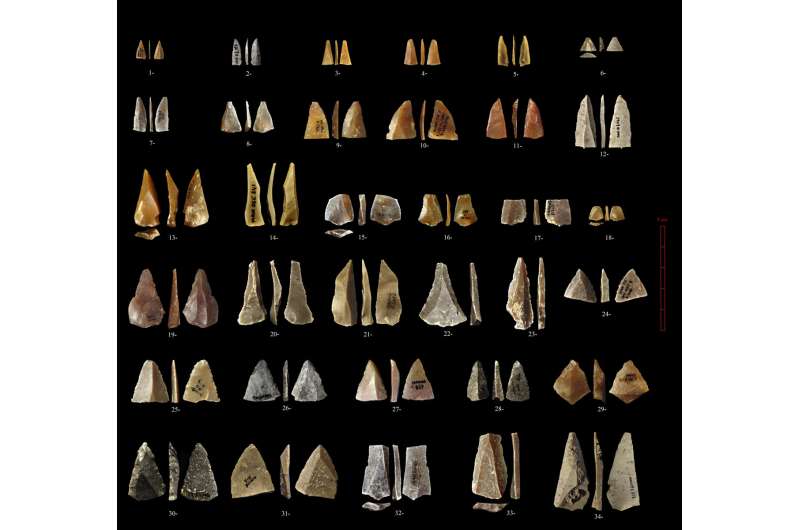

Similar tools from almost the exact same period have been found some 3,000 kilometers (nearly 1,900 miles) away, in present-day Lebanon, indicating that modern humans with a common culture may have traveled across the Mediterranean Sea, said Ludovic Slimak, one of the lead authors of the new study.
While the researchers found no evidence of cultural exchanges between the Neanderthals and modern humans who alternated in the cave, the rapid succession of occupants is in itself significant, they said. In one case, the cave changed hands in the space of about a year, said Slimak.
Katerina Harvati, a professor of paleoanthropology at the University of Tuebingen, Germany, who was not involved in the study, said the findings upend the idea that most of the European continent was the exclusive domain of Neanderthals until 45,000 years ago.
-

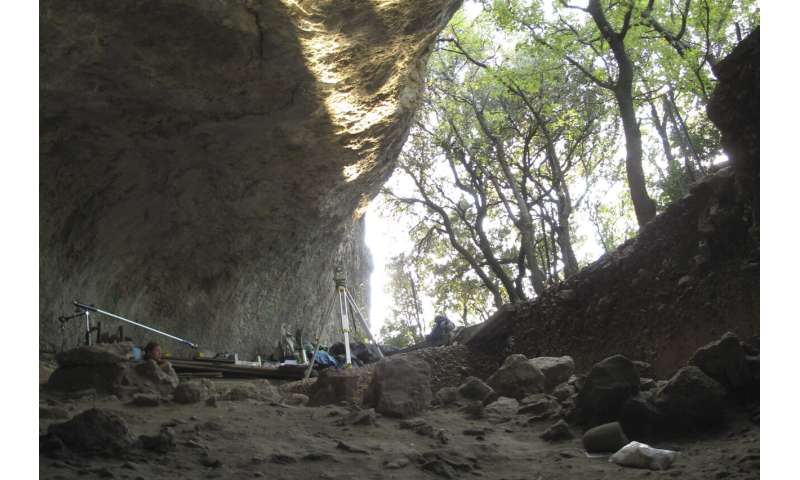
This undated photo provided by Ludovic Slimak shows scientists working at the entrance of the Mandrin cave, near Montelimar, southern France. Scientists have uncovered fossilized modern human remains and tools sandwiched between Neanderthal remains and tools in the stratigraphic record at a site in the Rhône Valley in France, suggesting occupation of the area alternated between Neanderthals and modern humans. Credit: Ludovic Slimak via AP
-

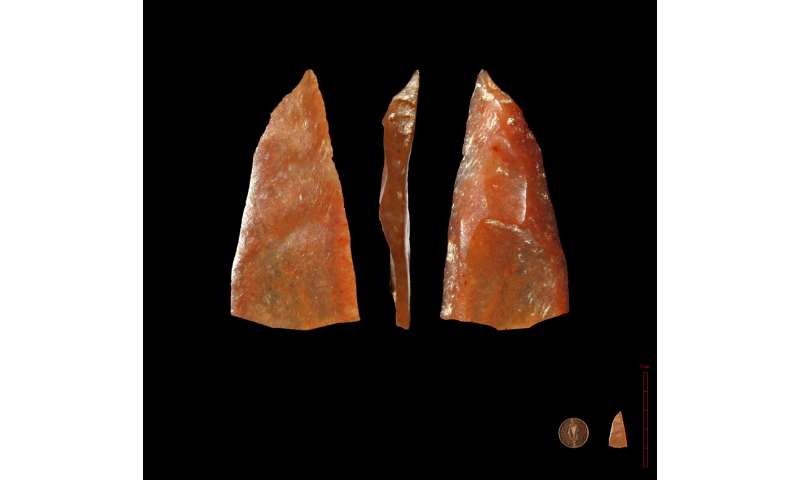
This undated photo provided by Ludovic Slimak shows nanopoints of the Modern Neronian technologies found in the Mandrin cave, near Montelimar, southern France. Scientists have uncovered fossilized modern human remains and tools sandwiched between Neanderthal remains and tools in the stratigraphic record at a site in the Rhône Valley in France, suggesting occupation of the area alternated between Neanderthals and modern humans. Credit: Ludovic Slimak via AP
-

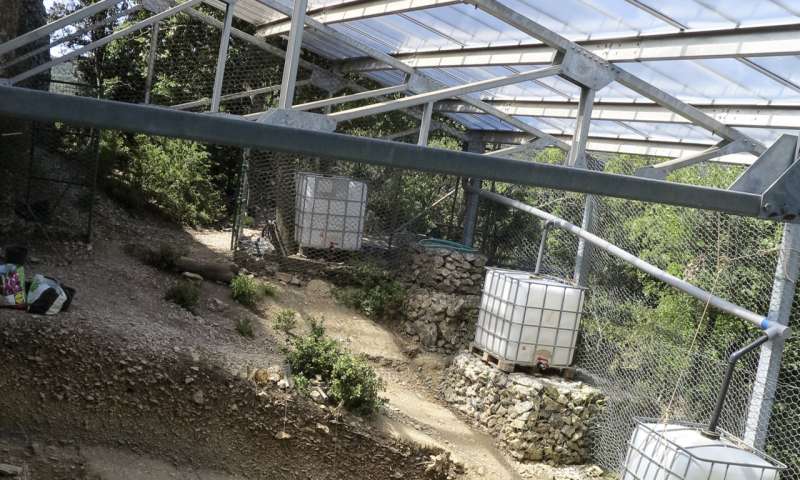
This undated photo provided by Ludovic Slimak shows excavations at the entrance of the Mandrin cave, near Montelimar, southern France. Scientists have uncovered fossilized modern human remains and tools sandwiched between Neanderthal remains and tools in the stratigraphic record at a site in the Rhône Valley in France, suggesting occupation of the area alternated between Neanderthals and modern humans. Credit: Ludovic Slimak via AP
However homo sapiens’ first venture into the region wasn’t particularly successful, she noted.
“Mandrin modern humans seem to have only survived for a very brief period of time and were replaced again by Neanderthals for several millennia,” she said.
Slimak, an archaeologist at the University of Toulouse, said the findings at Mandrin suggest the Rhone River may have been a key link between the Mediterranean coast and continental Europe.
“We are dealing with one of the most important natural migration corridors of all the ancient world,” he said.
-

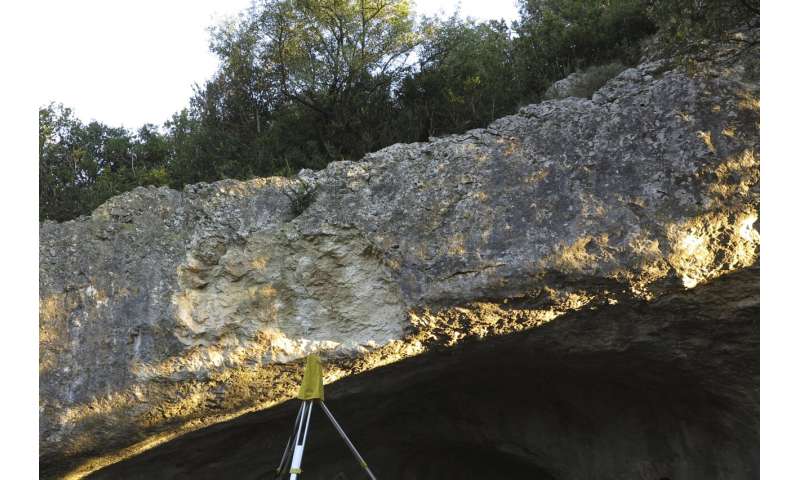
This undated photo provided by Ludovic Slimak shows the entrance of the Mandrin cave, near Montelimar, southern France. Scientists have uncovered fossilized modern human remains and tools sandwiched between Neanderthal remains and tools in the stratigraphic record at a site in the Rhône Valley in France, suggesting occupation of the area alternated between Neanderthals and modern humans. Credit: Ludovic Slimak via AP
-

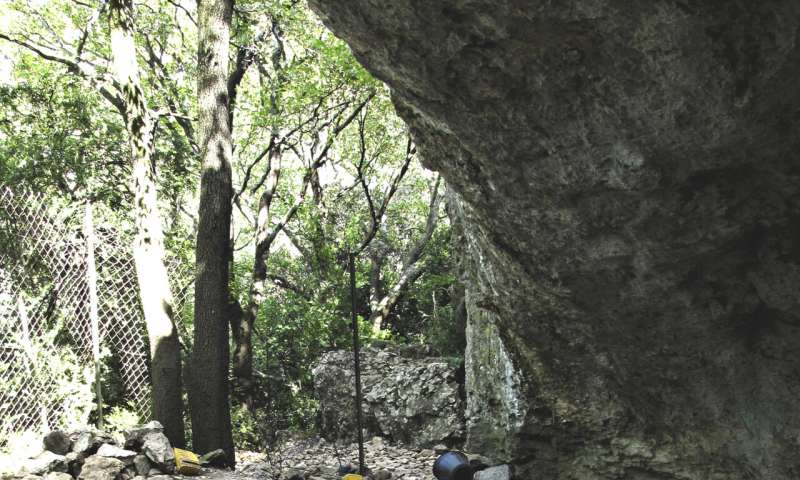
This undated photo provided by Ludovic Slimak shows the excavation on the Neronian layer dated to 54.000 years old and recording the first Home sapiens in the European continent, near Montelimar, southern France. Scientists have uncovered fossilized modern human remains and tools sandwiched between Neanderthal remains and tools in the stratigraphic record at a site in the Rhône Valley in France, suggesting occupation of the area alternated between Neanderthals and modern humans. Credit: Ludovic Slimak via AP
-

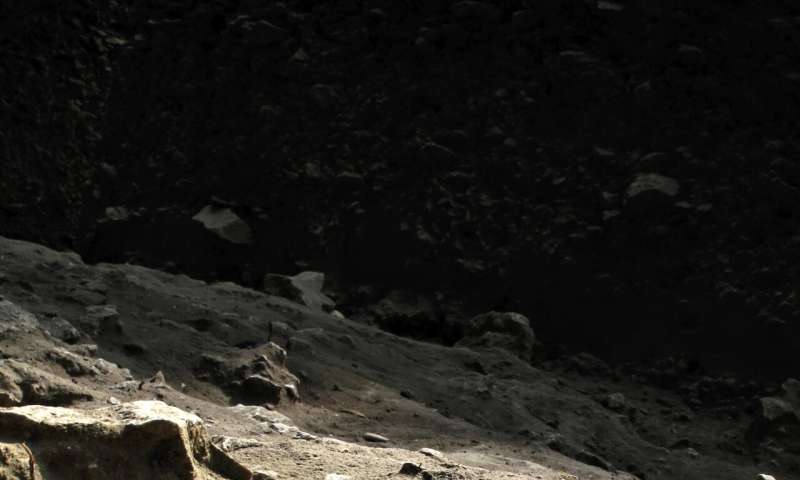
This undated photo provided by Ludovic Slimak showq a long blade of the Neronian of Grotte Mandrin, near Montelimar, southern France. Scientists have uncovered fossilized modern human remains and tools sandwiched between Neanderthal remains and tools in the stratigraphic record at a site in the Rhône Valley in France, suggesting occupation of the area alternated between Neanderthals and modern humans. Credit: Ludovic Slimak via AP
He and his colleagues expect to publish several further significant findings based on the mountain of data collected from the cave. Slimak said a steady supply of sand carried in by the local Mistral winds has helped preserve a rich trove of treasures that rivals other famous archaeological sites.
“Mandrin is like a kind of Neanderthalian Pompeii,” he said.
Explore further
Closer look shows Neanderthals on La Cotte de St Brelade interbred with modern humans
Ludovic Slimak et al, Modern human incursion into Neanderthal territories 54,000 years ago at Mandrin, France, Science Advances (2022). DOI: 10.1126/sciadv.abj9496. www.science.org/doi/10.1126/sciadv.abj9496
© 2022 The Associated Press. All rights reserved. This material may not be published, broadcast, rewritten or redistributed without permission.
Citation:
French cave tells new story about Neanderthals, early humans (2022, February 9)
retrieved 9 February 2022
from https://phys.org/news/2022-02-french-cave-story-neanderthals-early.html
This document is subject to copyright. Apart from any fair dealing for the purpose of private study or research, no
part may be reproduced without the written permission. The content is provided for information purposes only.
Science
Marine plankton could act as alert in mass extinction event: UVic researcher – Saanich News


A University of Victoria micropaleontologist found that marine plankton may act as an early alert system before a mass extinction occurs.
With help from collaborators at the University of Bristol and Harvard, Andy Fraass’ newest paper in the Nature journal shows that after an analysis of fossil records showed that plankton community structures change before a mass extinction event.
“One of the major findings of the paper was how communities respond to climate events in the past depends on the previous climate,” Fraass said in a news release. “That means that we need to spend a lot more effort understanding recent communities, prior to industrialization. We need to work out what community structure looked like before human-caused climate change, and what has happened since, to do a better job at predicting what will happen in the future.”
According to the release, the fossil record is the most complete and extensive archive of biological changes available to science and by applying advanced computational analyses to the archive, researchers were able to detail the global community structure of the oceans dating back millions of years.
A key finding of the study was that during the “early eocene climatic optimum,” a geological era with sustained high global temperatures equivalent to today’s worst case global warming scenarios, marine plankton communities moved to higher latitudes and only the most specialized plankton remained near the equator, suggesting that the tropical temperatures prevented higher amounts of biodiversity.
“Considering that three billion people live in the tropics, the lack of biodiversity at higher temperatures is not great news,” paper co-leader Adam Woodhouse said in the release.
Next, the team plans to apply similar research methods to other marine plankton groups.
Read More: Global study, UVic researcher analyze how mammals responded during pandemic
Science
The largest marine reptile ever could match blue whales in size – Ars Technica


Blue whales have been considered the largest creatures to ever live on Earth. With a maximum length of nearly 30 meters and weighing nearly 200 tons, they are the all-time undisputed heavyweight champions of the animal kingdom.
Now, digging on a beach in Somerset, UK, a team of British paleontologists found the remains of an ichthyosaur, a marine reptile that could give the whales some competition. “It is quite remarkable to think that gigantic, blue-whale-sized ichthyosaurs were swimming in the oceans around what was the UK during the Triassic Period,” said Dean Lomax, a paleontologist at the University of Manchester who led the study.
Giant jawbones
Ichthyosaurs were found in the seas through much of the Mesozoic era, appearing as early as 250 million years ago. They had four limbs that looked like paddles, vertical tail fins that extended downward in most species, and generally looked like large, reptilian dolphins with elongated narrow jaws lined with teeth. And some of them were really huge. The largest ichthyosaur skeleton so far was found in British Columbia, Canada, measured 21 meters, and belonged to a particularly massive ichthyosaur called Shonisaurus sikanniensis. But it seems they could get even larger than that.
What Lomax’s team found in Somerset was a surangular, a long, curved bone that all reptiles have at the top of the lower jaw, behind the teeth. The bone measured 2.3 meters—compared to the surangular found in the Shonisaurus sikanniensis skeleton, it was 25 percent larger. Using simple scaling and assuming the same body proportions, Lomax’s team estimated the size of this newly found ichthyosaur at somewhere between 22 and 26 meters, which would make it the largest marine reptile ever. But there was one more thing.
Examining the surangular, the team did not find signs of the external fundamental system (EFS), which is a band of tissue present in the outermost cortex of the bone. Its formation marks a slowdown in bone growth, indicating skeletal maturity. In other words, the giant ichthyosaur was most likely young and still growing when it died.
Correcting the past
In 1846, five large bones were found at the Aust Cliff near Bristol in southwestern England. Dug out from the upper Triassic rock formation, they were dubbed “dinosaurian limb bone shafts” and were exhibited in the Bristol Museum, where one of them was destroyed by bombing during World War II.
But in 2005, Peter M. Galton, a British paleontologist then working at the University of Bridgeport, noticed something strange in one of the remaining Aust Cliff bones. He described it as an “unusual foramen” and suggested it was a nutrient passage. Later studies generally kept attributing those bones to dinosaurs but pointed out things like an unusual microstructure that was difficult to explain.
According to Lomax, all this confusion was because the Aust Cliff bones did not belong to dinosaurs and were not parts of limbs. He pointed out that the nutrient foramen morphology, shape, and microstructure matched with the ichthyosaur’s bone found in Somerset. The difference was that the EFS—the mark of mature bones—was present on the Aust Cliff bones. If Lomax is correct and they really were parts of ichthyosaurs’ surangular, they belonged to a grown individual.
And using the same scaling technique applied to the Somerset surangular, Lomax estimated this grown individual to be over 30 meters long—slightly larger than the biggest confirmed blue whale.
Looming extinction
“Late Triassic ichthyosaurs likely reached the known biological limits of vertebrates in terms of size. So much about these giants is still shrouded by mystery, but one fossil at a time, we will be able to unravel their secrets,” said Marcello Perillo, a member of the Lomax team responsible for examining the internal structure of the bones.
This mystery beast didn’t last long, though. The surangular bone found in Somerset was buried just beneath a layer full of seismite and tsunamite rocks that indicate the onset of the end-Triassic mass extinction event, one of the five mass extinctions in Earth’s history. The Ichthyotian severnensis, as Lomax and his team named the species, probably managed to reach an unbelievable size but was wiped out soon after.
The end-Triassic mass extinction was not the end of all ichthyosaurs, though. They survived but never reached similar sizes again. They faced competition from plesiosaurs and sharks that were more agile and swam much faster, and they likely competed for the same habitats and food sources. The last known ichthyosaurs went extinct roughly 90 million years ago.
PLOS ONE, 2024. DOI: 10.1371/journal.pone.0300289
Science
Jeremy Hansen – The Canadian Encyclopedia


Early Life and Education
Jeremy Hansen grew up on a farm near the community of Ailsa Craig, Ontario, where he attended elementary school. His family moved to Ingersoll,
Ontario, where he attended Ingersoll District Collegiate Institute. At age 12 he joined the 614 Royal Canadian Air Cadet Squadron in London, Ontario. At 16 he earned his Air Cadet
glider pilot wings and at 17 he earned his private pilot licence and wings. After graduating from high school and Air Cadets, Hansen was accepted for officer training in the Canadian Armed Forces (CAF). He was trained at Chilliwack, British Columbia, and the Royal Military College at Saint-Jean-sur-Richelieu,
Quebec. Hansen then enrolled in the Royal Military College of Canada in Kingston,
Ontario. In 1999, he completed a Bachelor of Science in space science with First Class Honours and was a Top Air Force Graduate from the Royal Military College. In 2000, he completed his Master of Science in physics with a focus on wide field of view satellite tracking.
CAF Pilot
In 2003, Jeremy Hansen completed training as a CF-18 fighter pilot with the 410 Tactical Fighter Operational Training Squadron at Cold Lake, Alberta.
From 2004 to 2009, he served by flying CF-18s with the 441 Tactical Fighter Squadron and the 409 Tactical Fighter Squadron. He also flew as Combat Operations Officer at 4 Wing Cold Lake. Hansen’s responsibilities included NORAD operations effectiveness,
Arctic flying operations and deployed exercises. He was promoted to the rank of colonel in 2017. (See also Royal Canadian Air Force.)
Career as an Astronaut
In May 2009, Jeremy Hansen and David Saint-Jacques were chosen out of 5,351 applicants in the Canadian Space Agency’s
(CSA) third Canadian Astronaut Recruitment Campaign. He graduated from Astronaut Candidate Training in 2011 and began working at the Mission Control Center in Houston, Texas, as capsule communicator (capcom, the person in Mission Control who speaks directly
to the astronauts in space.


As a CSA astronaut, Hansen continues to develop his skills. In 2013, he underwent training in the High Arctic and learned how to conduct geological fieldwork (see Arctic Archipelago;
Geology). That same year, he participated in the European Space Agency’s CAVES program in Sardinia, Italy. In that human performance experiment Hansen lived underground for six days.
In 2014, Hansen was a member of the crew of NASA Extreme Environment Mission Operations (NEEMO) 19. He spent seven days off Key Largo, Florida, living in the Aquarius habitat on the ocean floor, which is used to simulate conditions of the International
Space Station and different gravity fields. In 2017, Hansen became the first Canadian to lead a NASA astronaut class, in which he trained astronaut candidates from Canada and the United States.
Did you know?
Hansen has been instrumental in encouraging young people to become part of the STEM (Science, Technology,
Engineering, Mathematics) workforce with the aim of encouraging future generations of space explorers.
His inspirational work in Canada includes flying a historical “Hawk One” F-86 Sabre jet.
Artemis II
In April 2023, Hansen was chosen along with Americans Christina Koch, Victor Glover and Reid Wiseman to crew NASA’s Artemis II mission to the moon. The mission, scheduled for no earlier
than September 2025 after a delay due to technical problems, marks NASA’s first manned moon voyage since Apollo 17 in 1972. The Artemis II astronauts will not land on the lunar
surface, but will orbit the moon in an Orion spacecraft. They will conduct tests in preparation for future manned moon landings, the establishment of an orbiting space station called Lunar Gateway, or Gateway, and a base on the moon’s surface where astronauts
can live and work for extended periods. The path taken by Orion will carry the astronauts farther from Earth than any humans have previously travelled. Hansen’s participation in Artemis II is a direct result of Canada’s contribution of Canadarm3
to Lunar Gateway. (See also Canadarm; Canadian Space Agency.)
“Being part of the Artemis II crew is both exciting and humbling. I’m excited to leverage my experience, training and knowledge to take on this challenging mission on behalf of Canada. I’m humbled by the incredible contributions and hard work of so many
Canadians that have made this opportunity a reality. I am proud and honoured to represent my country on this historic mission.” – Jeremy Hansen (Canadian Space Agency, 2023)
Did you know?
On his Artemis II trip, Hansen will wear an Indigenous-designed mission patch created for him by Anishinaabe artist Henry Guimond.
[embedded content]
Honours and Awards
-



 Science9 hours ago
Science9 hours agoJeremy Hansen – The Canadian Encyclopedia
-



 Investment9 hours ago
Investment9 hours agoUK Mulls New Curbs on Outbound Investment Over Security Risks – BNN Bloomberg
-



 Tech8 hours ago
Tech8 hours agoSave $700 Off This 4K Projector at Amazon While You Still Can – CNET
-



 Tech7 hours ago
Tech7 hours ago'Kingdom Come: Deliverance II' Revealed In Epic New Trailer And It Looks Incredible – Forbes
-



 Sports7 hours ago
Sports7 hours agoAuston Matthews denied 70th goal as depleted Leafs lose last regular-season game – Toronto Sun
-
Real eState8 hours ago
Sick of Your Blue State? These Real Estate Agents Have Just the Place for You. – The New York Times
-



 Health22 hours ago
Health22 hours agoSupervised consumption sites urgently needed, says study – Sudbury.com
-
News22 hours ago
Canada's 2024 budget announces 'halal mortgages'. Here's what to know – National Post





